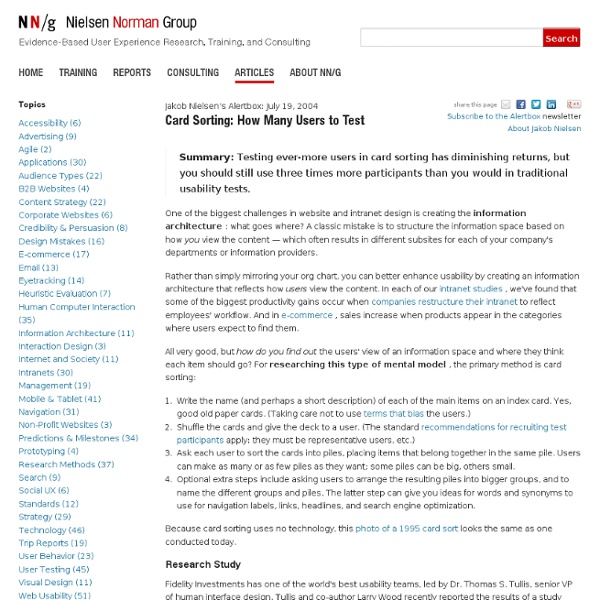



Information design using card sorting Written by James Robertson, published February 19th, 2001 Categorised under: articles, usability & information architecture At the beginning of any information design exercise, it is normal to be confronted by a very long list of potential subjects to include. While careful investigation and analysis of the information may reveal some clues, it can be virtually impossible to determine which topics should be grouped together. The difficulty in organising the content stems from a lack of knowledge about how real users make use of this information. A card sorting session can go a long way towards resolving this problem. What is card sorting? In essence, card sorting works as follows: Write down each topic on a filing (index) card. This is a very simple, and often very effective, method of working with users to come up with a usable design. It should be noted, however, that a card sorting exercise does not produce a finished information design. Why use this method? Simple, and well understood.
Card Sorting Project Management (4) A project plan takes into account the approach the team will take and helps the team and stakeholders document decisions made regarding the objective, scope, schedule, resources, and... Creating an interdisciplinary team with the right mix of skills is vital to the smooth and successful execution of any project. Team members may be able to cover multiple roles or there may... Use your kick-off meeting to discuss the business case related to the site, the vision and mission based on user and organizational goals, and the vision for the site moving forward. Website requirements are a list of necessary functions, capabilities, or characteristics related to your website and the plans for creating it. User Research (14) When reporting results from a usability test, you should focus primarily on your findings and recommendations that are differentiated by levels of severity. Usability Evaluation (14) Information Architecture (4) User Interface Design (4)
Planning And Implementing Website Navigation - Smashing Magazine Advertisement The thing that makes navigation difficult to work with in Web design is that it can be so versatile. Navigation can be simple or complex: a few main pages or a multi-level architecture; one set of content for logged-in users and another for logged-out users; and so on. Because navigation can vary so much between websites, there are no set guidelines or how-to’s for organizing navigation. Designing navigation is an art in itself, and designers become better at it with experience. Organizing Navigation Structure Perhaps the most difficult part about navigation on the Web is organizing and designing it. Primary vs. Most websites, especially those with a lot of content or functionality, need navigation menus. 1SpeckyBoy2 You might assume that the primary and secondary navigations are marked in a wrong way on the image above, but I believe that this is not the case. Primary navigation stands for the content that most users are interested in. Information Architecture: Card Sorting